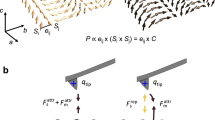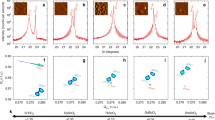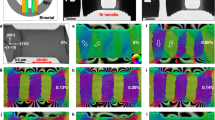Abstract
Among the variety of magnetic textures available in nature, antiferromagnetism is one of the most ‘discrete’ because of the exact cancellation of its staggered internal magnetization. It is therefore very challenging to probe. However, its insensitivity to external magnetic perturbations, together with the intrinsic sub-picosecond dynamics, make it very appealing for tomorrow’s information technologies1. Thus, it is essential to understand the microscopic mechanisms governing antiferromagnetic domains to achieve accurate manipulation and control. Using optical second-harmonic generation, a unique and laboratory-available tool2, we succeeded in imaging with sub-micrometre resolution both electric and antiferromagnetic orders in the model multiferroic BiFeO3. We show here that antiferromagnetic domains can be manipulated with low power consumption, using sub-coercive electric fields and sub-picosecond light pulses. Interestingly, we also show that antiferromagnetic and ferroelectric domains can behave independently, thus revealing that magneto-electric coupling can lead to various arrangements of the two orders.
This is a preview of subscription content, access via your institution
Access options
Access Nature and 54 other Nature Portfolio journals
Get Nature+, our best-value online-access subscription
$29.99 / 30 days
cancel any time
Subscribe to this journal
Receive 12 print issues and online access
$259.00 per year
only $21.58 per issue
Buy this article
- Purchase on Springer Link
- Instant access to full article PDF
Prices may be subject to local taxes which are calculated during checkout




Similar content being viewed by others
References
Jungwirth, T., Marti, X., Wadley, P. & Wunderlich, J. Antiferromagnetic spintronics. Nat. Nanotech. 11, 231–241 (2016).
Fiebig, M., Pavlov, V. V. & Pisarev, R. V. Second-harmonic generation as a tool for studying electronic and magnetic structures of crystals: review. J. Opt. Soc. Am. B 22, 96–118 (2005).
Yamada, T., Saito, S. & Shimomura, Y. Magnetic anisotropy, magnetostricition, and magnetic domain walls in NiO. II. Experiment. J. Phys. Soc. Japan 21, 672–680 (1966).
Catalan, G. & Scott, J. F. Physics and applications of bismuth ferrite. Adv. Mater. 21, 2463–2485 (2009).
Park, B. G. et al. A spin-valve-like magnetoresistance of an antiferromagnet-based tunnel junction. Nat. Mater. 10, 347–351 (2011).
Wadley, P. et al. Electrical switching of an antiferromagnet. Science 351, 587–590 (2016).
Arai, K. et al. Three-dimensional spin orientation in antiferromagnetic domain walls of NiO studied by X-ray magnetic linear dichroism photoemission electron microscopy. Phys. Rev. B 85, 104418 (2012).
Hillebrecht, F. U. et al. Magnetic moments at the surface of antiferromagnetic NiO(100). Phys. Rev. Lett. 86, 3419 (2001).
Zhao, T. et al. Electrical control of antiferromagnetic domains in multiferroic BiFeO3 films at room temperature. Nat. Mater. 5, 823–829 (2006).
Fiebig, M., Lottermoser, Th., Frölich, D., Goltsev, A. V. & Pisarev, R. V. Observation of coupled magnetic and electric domains. Nature 419, 818–820 (2002).
Fiebig, M. et al. Determination of the magnetic symmetry of hexagonal manganites by second harmonic generation. Phys. Rev. Lett. 84, 5620 (2000).
Sando, D. et al. Crafting the magnonic and spintronic response of BiFeO3 films by epitaxial strain. Nat. Mater. 12, 641–646 (2013).
Ederer, C. & Spaldin, N. A. Weak ferromagnetism and magnetoelectric coupling in bismuth ferrites. Phys. Rev. B 71, 060401(R) (2005).
Balke, N. et al. Deterministic control of ferroelastic switching in multiferroic materials. Nat. Nanotech. 4, 868–875 (2009).
Trassin, M., De Luca, G., Manz, S. & Fiebig, M. Probing ferroelectric domain engineering in BiFeO3 thin films by second harmonic generation. Adv. Mater. 27, 4871–4876 (2015).
Hertzer, G. in Handbook of Magnetism and Advanced Magnetic Materials Vol. 4 (eds Kronmueller, H. & Parkin, S.) (John Wiley, 2007).
Gomonay, H. & Loktev, V. M. Magnetostriction and magnetoelastic domains in antiferromagnets. J. Phys. Cond. Matter 14, 3959 (2002).
Lebeugle, D. et al. Electric-field-induced spin-flop in BiFeO3 single crystals at room-temperature. Phys. Rev. Lett. 100, 227602 (2008).
Heron, J. T. et al. Deterministic switching of ferromagnetism at room temperature using an electric field. Nature 516, 370–373 (2014).
Infante, I. C. et al. Bridging multiferroic phase transitions by epitaxial strain in BiFeO3 . Phys. Rev. Lett. 105, 057601 (2010).
Ramirez, M. O. et al. Magnon sidebands and spin-charge coupling in bismuth ferrite probed by nonlinear optical spectroscopy. Phys. Rev. B 79, 224106 (2009).
Kadomtseva, A. M. et al. Phase transitions in multiferroic BiFeO3 crystals, thin-layers, and ceramics: enduring potential for a single phase, room-temperature magnetoelectric ‘holy grail’. Phase Trans. 79, 1019–1042 (2006).
Catalan, G., Seidel, J., Ramesh, R. & Scott, J. F. Domain wall nanoelectronics. Rev. Mod. Phys. 84, 119 (2012).
Talbayev, D., Lee, S., Cheong, S.-W. & Taylor, A. J. Terahertz wave generation via optical rectification from multiferroic BiFeO3 . Appl. Phys. Lett. 93, 212906 (2008).
Acknowledgements
The research leading to these results received funding from the ‘Région Ile de France’ under the contract ‘CALPHOSPIN’, from the ‘Agence Nationale de la Recherche’ project MULTIDOLLS (ANR-12-BS04-0010-02) and from the ‘programme transversal nanosciences Acospin’. We would also like to thank R. Belkhou, A. Mougin and A. Thiaville for the loan of some equipment and C. Mocuta for crystallographic measurements on the films. We acknowledge fruitful discussions with F. Charra, C. Fiorini, A. Zvezdin and M. Fiebig as well as invaluable technical support from G. LeGoff and G. Cannies. Lastly, we thank B. Dkhil and M. Bibes for a critical reading of the manuscript.
Author information
Authors and Affiliations
Contributions
J.-Y.C., E.H. and M.V. performed the SHG measurements and analysis. J.-Y.C. and M.V. developed the SHG setup. S.F. performed the PFM measurements and analysis. C.C. grew and characterized the BFO samples. J.-Y.C., S.F. and M.V. wrote the manuscript. All authors contributed to the discussions.
Corresponding author
Ethics declarations
Competing interests
The authors declare no competing financial interests.
Supplementary information
Supplementary Information
Supplementary Information (PDF 334 kb)
Rights and permissions
About this article
Cite this article
Chauleau, JY., Haltz, E., Carrétéro, C. et al. Multi-stimuli manipulation of antiferromagnetic domains assessed by second-harmonic imaging. Nature Mater 16, 803–807 (2017). https://doi.org/10.1038/nmat4899
Received:
Accepted:
Published:
Issue Date:
DOI: https://doi.org/10.1038/nmat4899
This article is cited by
-
Magnetoelectric coupling in multiferroics probed by optical second harmonic generation
Nature Communications (2023)
-
Correlative imaging of ferroelectric domain walls
Scientific Reports (2022)
-
Multilevel polarization switching in ferroelectric thin films
Nature Communications (2022)
-
Giant second-harmonic generation in ferroelectric NbOI2
Nature Photonics (2022)
-
Antiferromagnetic textures in BiFeO3 controlled by strain and electric field
Nature Communications (2020)



